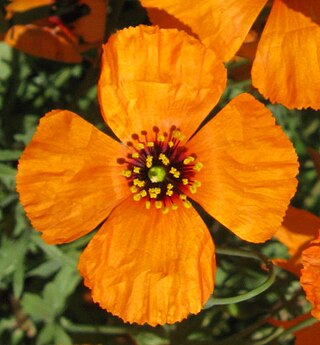
Aquilegia is a genus of about 130 species of perennial plants that are found in meadows, woodlands, and at higher elevations throughout the Northern Hemisphere, known for the spurred petals of their flowers.

Chromoplasts are plastids, heterogeneous organelles responsible for pigment synthesis and storage in specific photosynthetic eukaryotes. It is thought that like all other plastids including chloroplasts and leucoplasts they are descended from symbiotic prokaryotes.

Aquilegia canadensis, the Canadian or Canada columbine, eastern red columbine, or wild columbine, is a species of flowering plant in the buttercup family Ranunculaceae. It is an herbaceous perennial native to woodland and rocky slopes in eastern North America, prized for its red and yellow flowers. It readily hybridizes with other species in the genus Aquilegia.

Aquilegia coerulea, the Colorado columbine, Rocky Mountain columbine, or blue columbine, is a species of flowering plant in the buttercup family Ranunculaceae, native to the Rocky Mountains and some of the surrounding states of the western United States. It is the state flower of Colorado. The Latin specific name coerulea means "sky blue".

Erythranthe cardinalis, the scarlet monkeyflower, is a flowering perennial in the family Phrymaceae. Together with other species in Mimulus section Erythranthe, it serves as a model system for studying pollinator-based reproductive isolation. It was formerly known as Mimulus cardinalis.

Aquilegia pubescens is a perennial flowering plant in the family Ranunculaceae, endemic to the Sierra Nevada in California. It is usually known by the common name Sierra columbine, and less frequently as the alpine columbine or Coville's columbine.

Erythranthe lewisii is a perennial plant in the family Phrymaceae. It is named in honor of explorer Meriwether Lewis. Together with other species in Erythranthe, it serves as a model system for studying pollinator-based reproductive isolation. It was formerly known as Mimulus lewisii.

Aquilegia chrysantha, the golden columbine, is a perennial herbaceous flowering plant native to the southwestern United States and northwestern Mexico. The plant, with a height of between 40 centimetres (16 in) and 120 centimetres (47 in), has yellow flowers. A. chrysantha. as with other members of the Aquilegia coerulea species complex, is evolved for pollination by hawkmoth. It favors moist environments in its mountainous range.

Aquilegia eximia, the serpentine columbine or Van Houtte's columbine, is a perennial species of flowering plant in the family Ranunculaceae, endemic to California.

Aquilegia flavescens, the yellow columbine, is a perennial species of flowering plant in the family Ranunculaceae, native to the Rocky Mountains of the United States and Canada.

Aquilegia elegantula, the western red columbine, is a perennial species of flowering plant in the family Ranunculaceae, native to the Southwestern United States and northern Mexico.

Aquilegia longissima, the long-spur columbine or long-spurred columbine, is a rare perennial flowering plant in the family Ranunculaceae that is native to northern Mexico, Texas, and Arizona.

The flora of the U.S. Sierra Nevada alpine zone is characterized by small, low growing, cushion and mat forming plants that can survive the harsh conditions in the high-altitude alpine zone above the timber line. These flora often occur in alpine fell-fields. The Sierra Nevada alpine zone lacks a dominant plant species that characterizes it, so may or may not be called a vegetation type. But it is found above the subalpine forest, which is the highest in a succession of recognized vegetation types at increasing elevations.

Erythranthe cuprea is a species of monkeyflower also known by the common name flor de cobre. It was formerly known as Mimulus cupreus. Its characteristics in nectar and petal shape are markedly different from other species in this genus found in Chile.

Papaver heterophyllum, previously known as Stylomecon heterophylla, and better known as the wind poppy, is a winter annual herbaceous plant. It is endemic to the western California Floristic Province and known to grow in the area starting from the San Francisco Bay Area of Central Western California southwards to northwestern Baja California, Mexico. Its main habitat is often described as mesic and shady, with loamy soils such as soft sandy loam, clay loam, and leaf mold loam.

Aquilegia alpina, often called the alpine columbine or breath of God, is a perennial species of flowering plant in the family Ranunculaceae, native to the western and central Alps. Though rare in its Swiss, Austrian, and Italian range, it is commonly found in the French Maritime Alps. A. alpina is appreciated for its light blue to blue-purple flowers.

Aquilegia sibirica, the Siberian columbine, is a species of flowering plant in the family Ranunculaceae native to the north-central Asian regions of Siberia, northern Mongolia, Kazakhstan, and Xinjiang. A hardy perennial plant, it prefers temperate environments. The Siberian columbine can be between 1 foot (0.30 m) and 2 feet (0.61 m) tall with flowers that are lilac-blue and white in color.

Aquilegia formosa var. truncata, also known as the red columbine or western columbine, is a perennial flowering plant in the family Ranunculaceae, native to the western United States.

Aquilegia buergeriana is a perennial species of flowering plant in the family Ranunculaceae, native to Japan.

Aquilegia desertorum, the desert columbine, is a perennial species of flowering plant in the family Ranunculaceae, native to the Southwestern United States.





















